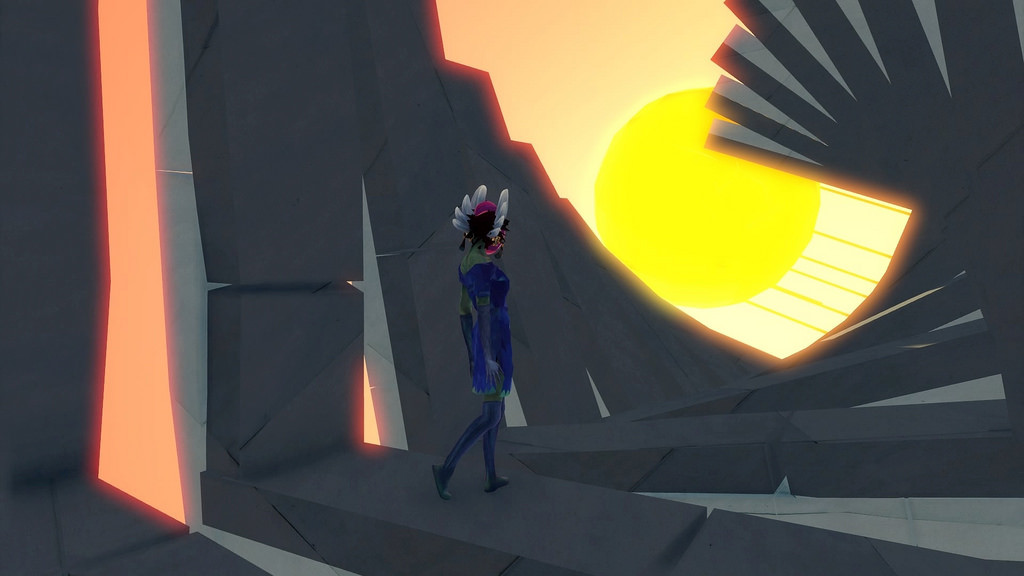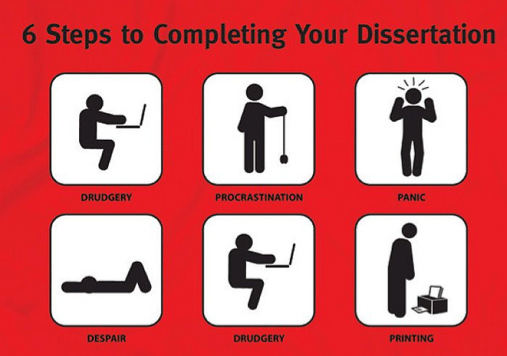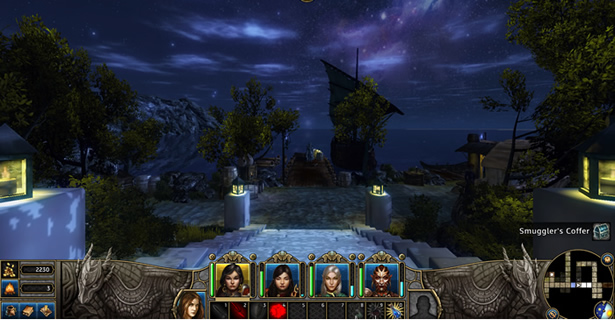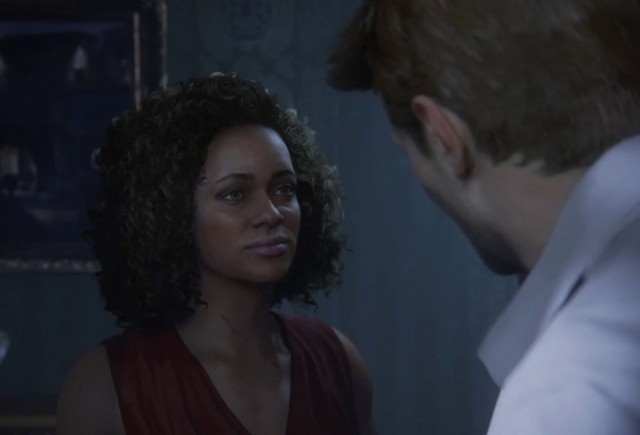Last weekend, the two of us played Bound (Plastic Demoscene Group), a game released last month that makes use of surreal landscapes and surreal storytelling. And its surreality and fluid fragmentation seem to work to construct a narrative and world that shifts and changes, that asks us to constantly question the world, its rules, and its story. It’s a game that, in one moment, centers on a pregnant woman walking on the beach and, in the next, transports us to a strange, dreamlike world and transforms us into a princess who dances through this environment. The interplay between these two worlds suggests that the latter surreal one is a manifestation of the pregnant woman’s memories of family and childhood trauma and her efforts to reconcile with her past. But the narrative that this constructs–like the gameworld itself–is fluid, shifting, disjointed, abstract. It is ambiguous and open to interpretation. It asks us to interrogate it.
We kept noting details—the main character’s changing dress, the way she moved, the addition of different graphical moments or mechanics—picking up on more, perhaps, than we might have if we were each playing alone. But with a buddy there, someone to elbow, someone to look when you point, discovery was exciting, and there are details worth discovering here. Options abounded. Prefer jumping? Jump away, from plank to plank. Nervous about the world shifting under your feet, and possibly altering a jump? No problem; slide along this wall. We started the game one day, and in our second play session, we started over, and quickly found we had more choices than we’d realized the first time.
But the low-stakes deaths and the lack of challenge balances against that. Die? Restart just where you were, no problem. Faced with a difficult moment? No problem, just look around; there’s probably a ladder or ledge that wasn’t immediately apparent. The monster often lurks not far away, grumbling, roaring, but is never any real danger. You will only really fail if you stop. Perhaps that’s a message there; maybe the monster isn’t quite as monstrous as he’s been built up to be. Maybe the only way to “win” this scenario is to move through all of it. But Bound never seems quite certain whether these kinds of moves are purposeful or accidents of interpretation, or at least, the game never quite clued us in on the truth, whatever that truth might be.
In “How to Recognize a Poem When You See One,” Stanley Fish recounts a day when he was teaching back-to-back classes, one on linguistics and literary criticism, and the second on English religious poetry in the 17th century. One day, as students entered for the second class, he directed their attention to the chalkboard, where a list of names had been left over from his previous class. Rather than telling the students they were looking at a list, however, he told them the list was in fact a poem, and the students set about working to interpret the “poem,” linking the names to the sorts of symbols they found in the work they’d been doing.
Fish uses this story as a springboard to talk about how meaning — how a poem — is created, even discovered by its interpreters, perhaps, maybe moreso than by its creator(s). All this to say is that we’re set from the beginning to believe Bound is going to have a particular sort of narrative of discovery. Everything in the layers of the game’s worlds is set up in this way: the main character in the outer world is on a physical and emotional journey, and the main character in the inner world is not only on a physical and emotional journey of her own, for her it is a specifically assigned quest. “Go and do the thing,” she is told, much like Stanley Fish told his students when he set them to analyzing the “poem.” Similarly, we are “told” by the game’s design to go and discover. Here are paths, the game says. Here is a mystery. You have a job to do.
And much like Fish’s students, we set about the work of discovery, finding paths, finding solutions, and searching endlessly for narrative clues in the game’s interstitials. We studied facial expression, positions of bodies, backgrounds, clothing, gestures, color, talking through everything, lingering over certain parts of rooms, struggling for detail in the decor and setting. We looked because the game told us to look, and we found a lot. But was it really there? We spoke often of ambiguity (“Is she mad? Look at her face. I’m not sure.”) and uncertainty, but still we searched. In the end, however, it’s hard to say what we found. There is a narrative. But it isn’t a neatly packaged story of what happened. There’s no closure. Even the ending choice offers little in the way of expected satisfaction.
 Yes, there is a narrative. And it is one with a lack of closure, one that revels in ambiguity, one that concludes with open-endedness. But what we have been grappling with and continuing to talk about the past few days is the fact that these ambiguous narrative structures don’t feel particularly satisfying. By the end of the game, we were left with more questions than answers (Is the mother the villain? The father? Both? No one?), and we continue to wonder how the game asks us to read it and make connections between its various spaces and plot points, how the game wants us to interpret its fragmented, ambiguous narrative. We even continue to wonder if the game is asking us to do such work at all. We think so. But if that’s the case, the game also limits us in our ability to engage with it because it often feels like there’s no there there–like there are no connections, ultimately, that can be made. That there is nothing substantial to take away from the game after playing it, other than that it is visually striking (and, at the end of the day, is that enough?).
Yes, there is a narrative. And it is one with a lack of closure, one that revels in ambiguity, one that concludes with open-endedness. But what we have been grappling with and continuing to talk about the past few days is the fact that these ambiguous narrative structures don’t feel particularly satisfying. By the end of the game, we were left with more questions than answers (Is the mother the villain? The father? Both? No one?), and we continue to wonder how the game asks us to read it and make connections between its various spaces and plot points, how the game wants us to interpret its fragmented, ambiguous narrative. We even continue to wonder if the game is asking us to do such work at all. We think so. But if that’s the case, the game also limits us in our ability to engage with it because it often feels like there’s no there there–like there are no connections, ultimately, that can be made. That there is nothing substantial to take away from the game after playing it, other than that it is visually striking (and, at the end of the day, is that enough?).
Maybe it is–and maybe, even, the game’s ambiguity is effective, in a way, for we both continue to think about and talk about the game, its landscapes, its use of dance, its construction of memory and childhood trauma, its representation of motherhood and fatherhood. If art is provocative, maybe the act of provocation is itself enough… but here, now, days later, we just keep thinking that maybe the barest hint of closure would have given the uncertainty the weight it seems designed to have. But maybe that, too, is its own statement. Maybe we never get to know. Maybe the frustration itself is the end goal. Finally, with Bound, we’re not sure, and not sure we’ll ever find any certainty at all.




